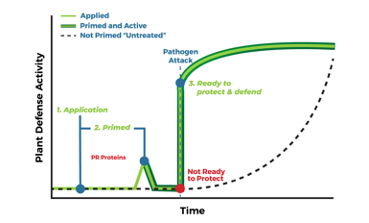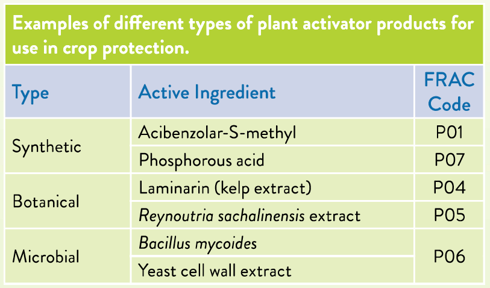By Certis Biologicals Field Development Team
During these challenging times, we extend our thanks to all of the agricultural professionals working to ensure the world has a steady supply of healthy food. We realize it is even harder now to balance all the demands that life places on you and your families, and want recognize all of you for putting forth the extra effort.
Here we will address a unique and reliable mode of action for fungal and bacterial disease control. These tools rely on the ability to trigger and amplify the natural defenses of plants in a reaction called Induced Resistance (IR). Induced Resistance to disease can be broken into two pathways, Systemic Acquired Resistance (SAR) and Induced Systemic Resistance (ISR). Although these pathways have many similarities, they do differ in their triggers, signaling molecules and final biochemical reactions. Since the vast majority of commercially available IR products utilize the SAR pathway that is the focus of this article.
Induced Resistance
Plants have the ability to activate biochemical defenses in response to attacks from pathogens. These induced defenses are expressed systemically throughout the plant, not only in the infected tissues. Systemic acquired resistance (SAR) is a type of induced defense that is triggered after local infection by pathogens, resulting in broad-spectrum (i.e., nonspecific) resistance to pathogen infection in parts distant from the point of primary infection. SAR is regulated by a set of signal transduction pathways, with salicylic acid (SA) acting as a key signaling molecule. The onset of SAR is marked by an “oxidative burst” of reactive oxygen species (ROS). This is followed by an associated increase in internally produced SA levels, leading to activation of defense-related genes that are coded to produce pathogenesis-related (PR) proteins having antimicrobial or other properties that limit disease development.
In response to the increased SA levels, oligomers of the regulatory protein NPR1 (NON-EXPRESSOR OF PATHOGENESIS RELATED GENES 1) in the cytoplasm are converted to active monomers small enough to be translocated through the nuclear membrane. Inside the nucleus, they stimulate transcription factors required for expression of PR genes coding for pathogenesis-related (PR) proteins. These are antimicrobial proteins such as chitinases, proteinases, peroxidases, and other compounds that disrupt infection processes or further transmit the defense signal to other parts of the plant. Functional analogs of SA such as the benzothiadiazole compound acibenzolar-S-methyl (ASM), and some microbes such as Bacillus mycoides isolate J (BmJ) can directly trigger monomerization of NPR1 and signal transduction in the absence of SA accumulation. Application of such “plant activators” results in elevated resistance to pathogen infection. Plants exposed to such stimuli often demonstrate a heightened state of alert, with more rapid and stronger response to secondary infection, a phenomenon known as “Priming.”
In addition to its role in SAR signal transduction, NPR1 has been determined to perform a similar function in defense pathways which use as signaling molecules the plant hormones jasmonic acid (JA) and ethylene. These include Induced Systemic Resistance (ISR) triggered by contact between plant roots and certain rhizobacteria, and induced defenses against herbivores such as insects.
Plant activators trigger immune responses in the plant even in the absence of a pathogen. This has been demonstrated using molecular and physiological techniques to monitor the signaling cascade and production of PR proteins following application. Priming of plants by such products prepares them to fend off disease when pathogens attack, as illustrated below:

Crops/Diseases Controlled and Available Products
Although there are a number of commercially available products that feature IR as either their primary or secondary mode of action, this table below focuses on the products that claim IR as their primary mode of action. These products have proven effective in controlling a number of diseases across a variety of crops. Examples include powdery and downy mildew in grapes, fire blight in pome fruits, Alternaria in almonds and carrots, and bacterial spot/speck in tomatoes.
Examples of different types of plant activator products for use in crop protection.

Biocontrol strains of Bacillus, Trichoderma, and other microbes that directly attack plant pathogens through competition, parasitism, and/or antimicrobial metabolites may trigger plant immune response as an additional mode of action.
Best Practices
Successful use of IR products requires a different approach to disease control compared to active ingredients that directly kill or compete with pathogenic microbes. The following guidelines should be applied whether the product contains chemical or biological plant activators:
- Apply early, just before infection occurs
- Allow for Induction time
- Many product labels call for application 3-5 days before expected disease
- Use in a program with other effective modes of action
- Can be used to supplement or replace other modes of action
- As part of a resistance management plan
- To boost overall control of hard to manage diseases
If used properly, IR compounds offer another effective tool to help growers successfully manage disease in many of their crops.
Conclusion
The world depends on growers and the agricultural professionals supporting them to supply healthy crops in the face of many challenges. The ag industry must work together to provide the tools, know-how, and resources needed to meet this demand – including the technology highlighted in this piece. We thank you for all that you do, each and every day, no matter what.
This article appeared in the June 2020 issue of CAPCA Adviser Magazine. You can read the original here.




